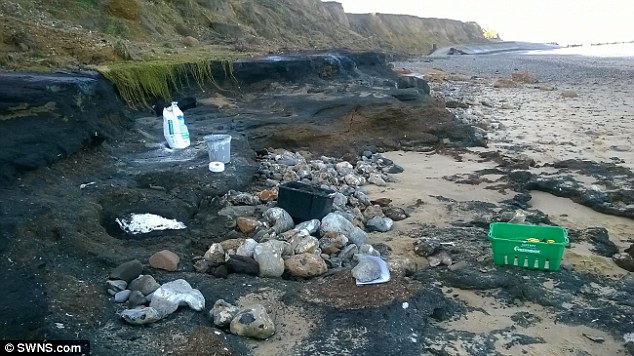It was teeth poking through the mud that caught an amateur fossil hunter’s attention.
The sight led Jonathan Stewart to discover the remains of a prehistoric rhino on a Norfolk beach, after the cliffs were eroded by stormy weather.
He came across the two rows of teeth at the foot of the cliffs at West Runton beach, which are thought to belong to a species of rhino that roamed the area around 700,000 years ago.
Prehistoric RHINO uncovered on a Norfolk beach: Stormy weather reveals 700,000-year-old creature's teeth
Remains were discovered on West Runton beach in Norfolk
A local geologist removed the bones to stop them being washed away
Thought to belong to rhino species Stephanorhinus hundsheimensis
Creature roamed the area 700,000 years ago, browsing for food
By Sarah Griffiths for MailOnline
4 February 2015
Daily Mail
It was teeth poking through the mud that caught an amateur fossil hunter’s attention.
The sight led Jonathan Stewart to discover the remains of a prehistoric rhino on a Norfolk beach, after the cliffs were eroded by stormy weather.
He came across the two rows of teeth at the foot of the cliffs at West Runton beach, which are thought to belong to a species of rhino that roamed the area around 700,000 years ago.

Teeth poking through the mud (pictured) caught an amateur fossil hunter’s attention and he discovered the remains of a prehistoric rhino, including two rows of teeth, some eroded parts of the skull or jaws, and bone that could be from the ribs
Mr Stewart called in local geologist Martin Evans to save the remains before they could be washed away, because he was due to catch a flight the following morning.
Mr Evans spent a day carefully removing the fossil by covering the exposed area with plaster of Paris before cutting around it.
The remains, which were uncovered last week, date from the Cromerian interglacial period - some 700,000 years ago. The period is named after the seaside town of Cromer, not far from West Runton.
Mr Evans spent a day carefully removing the fossil by covering the exposed area with plaster of Paris before cutting around it.
The remains, which were uncovered last week, date from the Cromerian interglacial period - some 700,000 years ago. The period is named after the seaside town of Cromer, not far from West Runton.


Jonathan Stewart (pictured left) discovered the remains of a prehistoric rhino on a beach at West Runton, after the cliffs were eroded by stormy weather. Local geologist Martin Evans stepped in to carefully remove the remains (pictured right) which were at risk of being washed away


Experts are working to determine which species of rhino the bones come from, but Mr Evans thinks they are likely from to the Stephanorhinus hundsheimensis. A mounted skeleton of the ancient species is shown
They include two rows of teeth, some eroded parts of the skull or jaws, and bone that could be from the ribs.
Experts are working to determine exactly which species of ancient rhino the bones come from, but Mr Evans thinks they are likely from to the Stephanorhinus hundsheimensis species.
He said: ‘They ranged across Europe and were adapted more for browsing rather than for grazing.’
One of the most complete skeletons of a mammoth ever found was uncovered on the same area of beach in 1990.
‘Anything found in the West Runton Freshwater Bed is significant,’ said Mr Evans, former curator of Cromer Museum.
‘It is another piece in the jigsaw of what Britain was like 700,000 years ago.
‘It was in danger of being washed away. I had to ensure I rescued it before the tide washed it away.’
Mr Evans, 63, who now runs a microbrewery, added: ‘Mr Stewart is quite experienced in collecting fossils - I would like to see him involved in the process of analysing and preserving it.
‘The ideal outcome would be for the findings to be donated to a public collection.’
Mr Stewart found a rhino bone in the same area in 2012 and Mr Evans discovered tooth rows from another rhino and an even older rhino femur in the 1980s and early 1990s.

The remains (pictured), which were uncovered last week, date from the Cromerian interglacial period - some 700,000 years ago. The period is named after Cromer, in Norfolk

One of the most complete skeletons of a mammoth ever found was uncovered on the same area of beach (pictured) in 1990. ‘Anything found in the West Runton Freshwater Bed is significant,’ said Mr Evans. ‘It is another piece in the jigsaw of what Britain was like 700,000 years ago'
WHAT IS STEPHANORHINUS HUNDSHEIMENSIS?
Stephanorhinus is an extinct genus of rhinoceros native to northern Eurasia that lived during the Lower to Early Late Pleistocene epoch.
An expert estimates the remains found in Norfolk are around 700,000 years old.
The prehistoric rhino had two horns and weighed over 6,613lbs (3,000kg).
It measured around seven ft (two metres) tall and 13 ft (four metres) long - a similar size to a white rhino.
There were two species of Stephanorhinus living in Eurasia at the time, but the remains are thought to belong to the species with a narrower nose.
Stephanorhinus hundsheimensis was an unspecialised animal evolved for browsing rather than grazing, while Stephanorhinus kirchbergensis, with its wider nose, preferred forest and woodland habitats.
Read more: Prehistoric RHINO Stephanorhinus uncovered on a Norfolk beach | Daily Mail Online
Follow us: @MailOnline on Twitter | DailyMail on Facebook
Last edited: